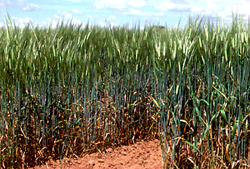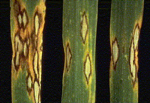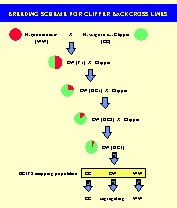Barley Molecular Markers

Scald, also known as leaf blotch, is the most severe foliar disease of barley in southern Australia. In Victoria, average yield losses due to scald infection are about 15%, although individual losses can be as high as 45%. Scald adversely affects grain quality, which is directly related to malting quality. As two thirds of barley production in Australia is for malting, this is a major problem for the industry.

Scald is caused by the fungal pathogen Rhynchosporium secalis. As well as these crops, scald infects two wild barley grasses that are agricultural weeds and act as reservoirs for inoculum. In barley cultivars resistant to scald, the germ tube penetrates the leaf cuticle, but thereafter fungal growth slows and eventually ceases. Limited chlorosis of the leaves may be seen.
Hordeum vulgare subsp. spontaneum, the wild progenitor of cultivated barley (H. vulgare), represents a significant genetic resource. We have a collection of H. spontaneum accessions that originate from several sites in Israel, Iran and Turkey. While H. spontaneum possesses desirable characters such as scald resistance, like all wild crop relatives it retains poor agronomic undesirable characters. Breeding strategies such as backcrossing used to remove poor agronomic traits inherited from the wild parent. The ease of crossing close relatives such as H. spontaneum with H. vulgare facilitates this. The development of molecular markers closely linked to desired phenotypes such as scald resistance aids breeders in incorporating desirable wild genes into their breeding lines, while avoiding carryover of undesirable phenotypes. This system provides an opportunity to exploit wild sources of resistance to scald, but the development of breeding strategies for specific introgression of beneficial genes from wild relatives offers a model of use in other crop systems.

The backcrossing strategy used to introgress genes from H. spontaneum into barley employed isozyme variation between the two parents. Different accessions of wild barley were crossed to the Australian malting barley cultivar Clipper, which is susceptible to scald. From the F1, BC1 and BC2 generations, plants heterozygous for a specific isozyme marker were selected for pollination with Clipper, and similarly in the BC3 population for selfing to produce a BC3F2. Scald resistance of BC3F2 plants was tested, and the isozyme marker was scored, allowing the degree of linkage between the isozyme and the resistance gene loci to be estimated. Closely linked isozyme markers can be used to track resistance loci in breeding programs; more loosely linked isozyme markers may be useful to locate the resistance gene on the barley genetic map and indicate potential DNA markers. Where linkage between isozyme markers and resistance loci is weak or lacking, use of marker technology such as amplified fragment length polymorphisms (AFLP) allows the full genome to be screened for polymorphisms between resistant and susceptible BC3F2 plants. These polymorphisms will be screened for linkage to the scald resistance phenotype; those that are closely linked will be developed into PCR based markers for use in breeding programs.
Scientific Staff: Brown, Genger
